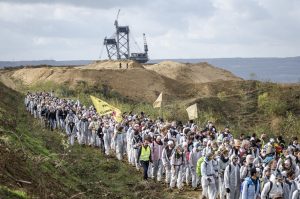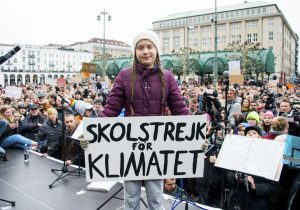 As the “Scaling Resistance” tour reaches its halfway mark, here are some impressions I’ve had from 2 weeks on the road with German climate activists Ende Gelaende (EG) and Rising Tide North America.
As the “Scaling Resistance” tour reaches its halfway mark, here are some impressions I’ve had from 2 weeks on the road with German climate activists Ende Gelaende (EG) and Rising Tide North America.
Starting with some impressions from Ende Gelaende presentation:
1) “We say what we do and we do what we say”: Ende Gelaende is radically transparent. Hundreds of people attend plenaries and make decisions on strategy and tactics. There are tens of direct action trainings, including those attended by media. Participants get regular updates on the action progress and can choose which of the “five fingers” (i.e. tactical) groups they wish to participate in. Ende Gelaende’s approach is to put out a big public call to action on their timeline and against the target they want. By dictating the terms of their action, they can do the work to ensure thousands of people show up, enough to get to almost any mine
2) Through a combination of symbolic and nonsymbolic action, Ende Gelaende has changed the debate in Germany. By focusing on huge coal mines, EG made many Germans, who were excited about the high level of renewals and energy transition, uncomfortable. But they changed the narrative in the country around coal and made the EG mass actions the happening event. As we speak, major papers are writing about this year’s action, which will be in mid-June. The actions are powerful for their symbolic value, they feature a “David versus Goliath” scenario, with thousands of small (at least in the pictures) people standing up to giant earth moving machinery and shutting down mine sites. And thisis a real shut down extraction, as thousands of people are able to stop coal mining operations for a day or coal train shipments for a day or two.
3) A small core of people can build something really big. Ende Gelaende grew out of the climate camps, grassroots groups like ausgeCO2hlt and others in the left who knew that they had to scale up their climate resistance. They used a threefold approach. First, they built relationships throughout the climate sector, including with larger nonprofits who supported their work in various ways and academic institutions, which participated in summer climate camps, providing a base for potential participants. Second, they traveled Germany and neighboring European countries giving Direct Action trainings encouraging the building of affinity groups. Finally, as mentioned earlier, they are masters at building buzz in the press and using all media outlets to their advantage. All of this is accomplished with only volunteers.
4) Civil Disobedience means something very different in Germany. In Ende Gelaende’s case, the goal is to go around the police and stop the mine, no arrests and a mine occupation is the very definition of success. If people are arrested, they do not have their IDs on them and sometimes even put superglue on their fingers to avoid identification, in the hopes (generally successful) that they will be released without charges because they cannot be identified.
Reactions to the presentation from U.S. audiences:
1) There is a lot of doubt on our side. We worry about all the ways Ende Gelaende’s approach is not applicable to the United States, whether that is about geography and density, or that people will not participate, or that legislative and regulatory strategies have efficacy. There is also real doubt about our collective ability to find the time, given the economic demands on so many of our volunteers.
2) There is also incredible enthusiasm for doing some experiments. Standing Rock showed us what is possible. There are tens of local fights against power plants, pipelines and extraction sites with thousands of courageous folks. There are also other interesting targets that get at the intersection of class and climate, like private airports. Finally, the same banks that fund extraction and pipelines are also the same banks that fund private prisons, immigrant detention centers, and the military industrial complex. There are lots of places with a lot of density, like the Northeast and the Northwest, who have crews of solid veteran organizers.
3) Race matters a lot more here than in Germany. Ende Gelaende is open about the fact that they are a predominantly white movement and need to work on that.. While not everyone who has attended our presentations has been white, this is a tour, and a slice of the movement that has been predominantly white, and has also skewed much older than Ende Gelaende. For us, being cognizant of race, and our nation’s history and present of colonialism, white supremacy and anti-blackness matters a lot. It also is vital to recognize that there is a rich and vibrant climate justice movement in the US. One of the key questions for us as we move forward is whether our work as white folks in the climate justice movement means we should be providing direct support to and coordination on actions with the most affected frontline communities, or whether we should be using our privilege to be putting our bodies on the line in ever more powerful ways against the largest corporations and points of extraction.
4) There is also a theory of change conversation. Many groups we are meeting with are focused on a winning a particular struggle, generally around policy or an infrastructure project. Obviously folks understand that winning is vital and part of a larger struggle, but we do not often connect the dots. What would it mean to view mass disruption that pushes on power as an inherent good in and of itself and as a theory of change. As Naomi Klein says, we need to change everything. Capitalism, colonialism, heteropatriarchy and white supremacy are the problems and climate change is a symptom. Could we be winning battles while losing the war?
Over the last three weeks we have been excited to share stories about scaling up the resistance, and our guests from Ende Gelaende have been excited to learn about the climate movements and other social movements here at home. We have done our best to make the teachings accessible to all, by offering webinars to those who are not at tour stops. Now, we ask for thoughts on what our next steps should be?
Are you thinking about mass action? Let us know! Should we be building a community of practice around scaling up? Should we have some advance webinars with Ende Galaede?
Should we be thinking about mass action, but in a much more intersectional way? Let us know what you think at: We will be in touch and follow the last three weeks of the tour on Twitter, Facebook and Instagram, as well as here on our website.
###
Jeff Ordower is a long-time community and labor organizer and a member of the Rising Tide Collective, who is currently peripatetic. You can follow the exploits of the second half of the tour at @risingtidena on Twitter.







